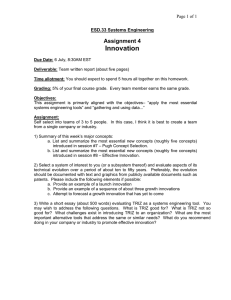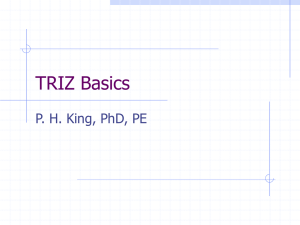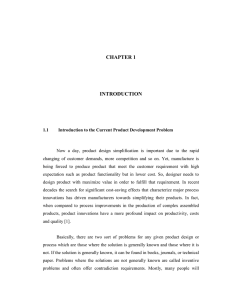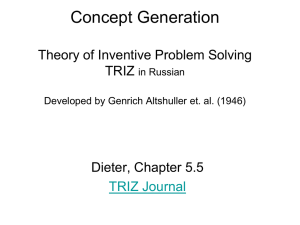TABLE OF CONTENTS
advertisement
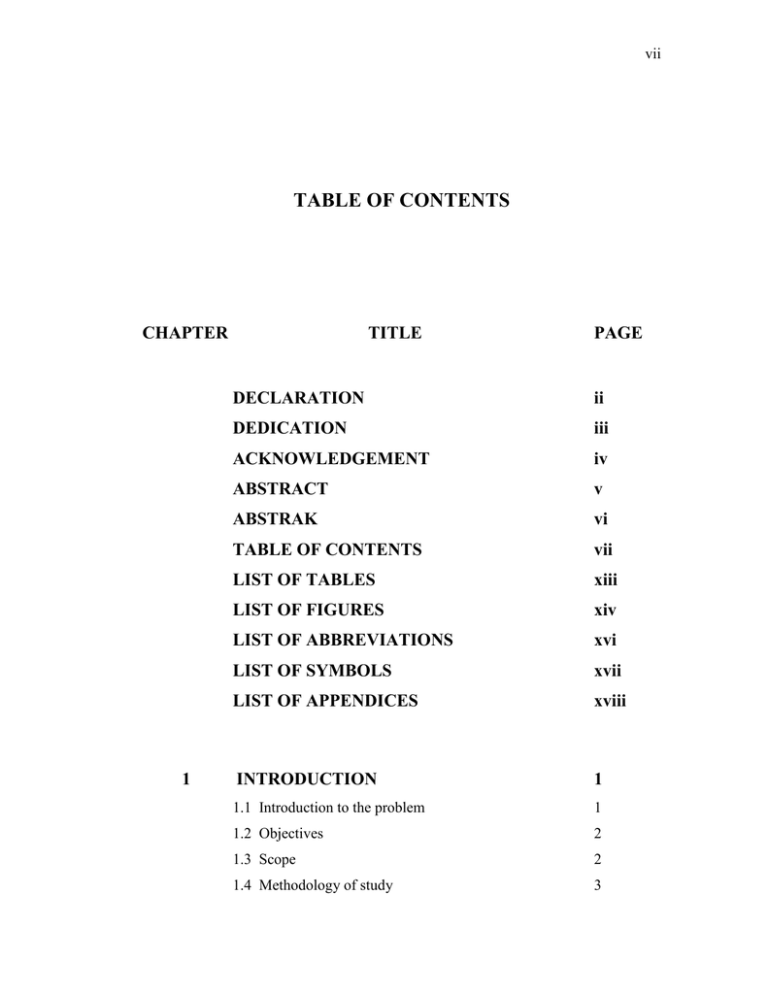
vii TABLE OF CONTENTS CHAPTER 1 TITLE PAGE DECLARATION ii DEDICATION iii ACKNOWLEDGEMENT iv ABSTRACT v ABSTRAK vi TABLE OF CONTENTS vii LIST OF TABLES xiii LIST OF FIGURES xiv LIST OF ABBREVIATIONS xvi LIST OF SYMBOLS xvii LIST OF APPENDICES xviii INTRODUCTION 1 1.1 Introduction to the problem 1 1.2 Objectives 2 1.3 Scope 2 1.4 Methodology of study 3 viii 2 1.5 Significant of study 5 1.6 Report structure 5 1.7 Summary 6 LITERATURE REVIEW 7 2.1 Introduction 7 2.2 Value Engineering 8 2.2.1 What is Value Engineering? 8 2.2.2 The Job Plan 9 2.2.3 How it Works? 11 2.3 Theory of Inventive Problem Solving (TRIZ) 12 2.3.1 History of TRIZ 12 2.3.2 What is TRIZ? 12 2.3.3 TRIZ Fundamental 13 2.3.3.1 Ideality 13 2.3.3.2 Functionality 14 2.3.3.3 Resource 15 2.3.3.4 Contradictions 17 2.3.3.5 Evolution 22 Additional TRIZ Tools 23 2.3.4 2.3.4.1 ARIZ (Algorithm for Inventive Problem Solving) 24 2.3.4.2 Su-Field Analysis 24 2.3.4.3 Anticipatory Failure Determination (AFD) 2.3.4.4 Directed Product Evolution (DPE) 2.3.5 25 Integration TRIZ with Others Problem Solving Tools 2.4 24 27 Design for Manufacture and Assembly (DFMA) 29 2.4.1 What is DFMA? 29 2.4.2 The DFMA Approach 30 ix 2.5 3 Summary TRIZ CONCEPT 33 3.1 Introduction 33 3.2 General TRIZ Process Procedures 34 3.2.1 Problem Definition 34 3.2.2 Problem Classification and Tool Selection 36 3.2.3 Solution Generation 37 3.2.4 Concept Evaluation 38 3.2.5 TRIZ Tool Selection 38 3.3 Technical Contradiction Elimination – Inventive Principle Method 38 3.3.1 Identify the Problem 39 3.3.2 Formulate the Problem 40 3.3.3 Previously Well-Solved Problem 41 3.3.4 Look for Analogous Solutions & Adapt To the Solution 3.4 4 32 Summary 41 45 PRODUCT CASE STUDY 46 4.1 Introduction 46 4.2 Product as Case Study 47 4.2.1 Product Selection 47 4.2.2 Product Tree Structure 48 4.2.3 Part ID Number 50 4.2.4 Assembly Sequence 51 4.3 Part Critique 51 4.4 Summary 56 x 5 6 DESIGN FOR ASSEMBLY (DFA) ANALYSIS FOR ORIGINAL DESIGN 57 5.1 Introduction 57 5.2 Classification of Product parts 58 5.3 Theoretical Minimum Parts Assessment 59 5.4 DFA Worksheet 60 5.5 Result 62 5.6 Summary 63 PROPOSED IMPROVEMENT OF NEW DESIGN USING DFMA METHODOLOGY AND TRIZ CONCEPT 64 6.1 Introduction 64 6.2 Improvement by Using DFMA Methodology 65 6.2.1 Improvement 1: Connector 65 6.2.2 Improvement 2: Wiper Holder 66 6.2.3 Improvement 3: Male Adjuster 67 6.2.4 Improvement 4: Female Adjuster 68 6.2.5 Improvement 5: Stopper 69 6.2.6 Improvement 6: Rod A 70 6.2.7 Improvement 7: Handle 71 6.2.8 Improvement 8: Joint 71 6.2.9 Improvement 9: Snap Fit Shaft 72 6.3 6.2.10 Improvement 10: Pusher 73 Improvement by Using TRIZ Concept 74 6.3.1 Improvement1: Pusher 74 6.3.2 Improvement 2: Male and Female Adjuster 75 6.3.3 Improvement 3: Joint 6.3.4 Improvement 4: Wiper Holder, Connector, 76 xi Arms and Pins 6.4 7 79 DFMA AND TRIZ ANALYSIS FOR NEW DESIGN 80 7.1 Introduction 80 7.2 DFMA Analysis for New Design 81 7.2.1 Classification of Product Parts 82 7.2.2 Theoretical Minimum Parts Assessment 83 7.2.3 DFA Worksheet 83 7.2.4 Result 85 7.2.5 DFM Analysis 86 7.3 7.4 8 Summary 77 TRIZ Analysis for New Design 87 7.3.1 Classification of Product Part 88 7.3.2 DFA Worksheet 89 7.3.3 Result 90 7.3.4 DFM Analysis 91 Summary 91 DISCUSSION 92 8.1 Introduction 92 8.2 Comparison of Product Case Study Result 93 8.2.1 Comparisons of DFMA Analysis Result 93 8.2.2 Comparisons of TRIZ Analysis Result 95 8.2.3 Comparisons between DFMA and TRIZ Improvement Result 8.3 Summary 98 99 xii 9 CONCLUSION 100 9.1 Introduction 100 9.2 Recommendations for Future Work 101 9.3 Concluding Remark 103 REFERENCES 105 APPENDICES 108 xiii LIST OF TABLES TABLE NO. TITLE PAGE 2.1 VE evaluation process. 11 2.2 Table of 39 parameters of contradiction 18 2.3 Table of 40 inventive principles 19 2.4 Pattern of evolution of technological systems 25 3.1 Table characteristic of beverage can through Innovative Situation Questionnaire 40 4.1 The Sponge Mop part ID number 50 4.2 Part critique of each part for Sponge Mop 52 5.1 Classification of Part for Original Design 58 5.2 DFA worksheet analysis for original design 60 7.1 Classification of Part for New Design by DFMA Methodology 7.2 82 DFA worksheet analysis for new design by DFMA Methodology 84 7.3 Classification of Part for New Design by TRIZ Concept 88 7.4 DFA worksheet analysis for new design by TRIZ 89 8.1 Effect of the improvement 93 8.2 Result of time saving due to the factor of design change 94 8.3 Effect of the improvement result 95 8.4 Effect of the integration improvement 98 xiv LIST OF FIGURES FIGURE NO TITLE PAGE 1.1 Flow chart of the project activities for MP 1 and MP 2. 4 2.1 Three steps to pre-analyze the conflict. 21 2.2 Curves of technical system evolution. 23 2.3 Integration of design problem-solving tools. 28 3.1 Four steps TRIZ process procedure. 34 3.2 Technical Contradiction Elimination – Inventive Principle step-by-step. 39 3.3 Result for the problem. 42 3.4 Cross section of corrugated can wall. 43 3.5 Spheroidality Strengthens Can's Load Bearing Capacity. Perpendicular angle has been replaced with a curve. 44 4.1 Sponge Mop. 48 4.2 Sponge Mop product tree structure. 49 6.1 Design improvement of Connector. 66 6.2 Design improvement of Wiper Holder. 67 6.3 Design improvement of Male Adjuster. 68 6.4 Design improvement of Female Adjuster. 69 6.5 Design improvement of Stopper. 70 6.6 Design improvement of Rod A. 70 6.7 Design improvement of Handle. 71 6.8 Design improvement of Joint. 72 6.9 New part design of Snap Fit Shaft. 73 xv 6.10 Improvement of Pusher quantity from two into one. 6.11 New design of Pusher by combining two pushers into one. 75 6.12 (a) New design of male adjuster with lock leaf, and (b) New design of female adjuster with lock slot. 6.13 78 Exploded drawing of new design of Sponge Mop via DFMA methodology 7.2 78 New design of wiper holder that designing to fit with the new connector design. 7.1 76 New design of connector based on idea from element in Principle 1. 6.14 73 81 Exploded view of new design of Sponge Mop via TRIZ concept 87 xvi LIST OF ABBREVIATIONS TRIZ - Theory of Inventive Problem Solving VE Value Engineering - DFMA - Design for Manufacture and Assembly MP 1 - Master Project 1 MP 2 - Master Project 2 DFA Design for Assembly - DFM - Design for Manufacture VA Value Analysis - ARIZ - Algorithm for Inventive Problem Solving QFD Quality Function Deployment - FMEA - Failure Mode Effect and Analysis 6σ - Six Sigma ID - Identification Q&A - Question and Answer TM - Assembly time CM - Assembly cost NM - Theoretical minimum number of part DE - Design efficiency xvii LIST OF SYMBOLS α - Alpha β - Beta n - Labor cost per second xviii LIST OF APPENDICES APPENDIX TITLE PAGE 1A Gantt chart 1: Project activities for Master Project Part 1 109 1B Gantt chart 2: Project activities for Master Project Part 2 110 2A Contradiction Table of 39 Parameters 111 2B The 40 Inventive Principles 117 2C DFA Worksheet 130 2D Table of Manual Handling Estimated Times 131 2E Table of Manual Insertion Estimated Times 132 2F Table of Compatibility between Processes and Materials 133 2G Table of Shape Generation Capabilities of Processes 134 7A Part Attributes of Each Part for New Design of Sponge Mop 7B Table of Primary Process and Material Selection for New Design 7C 136 Part Attributes of Each Part for New Design of Sponge Mop by TRIZ Concept 7D 135 138 Table of Primary Process and Material Selection for New Design by TRIZ Concept 139
